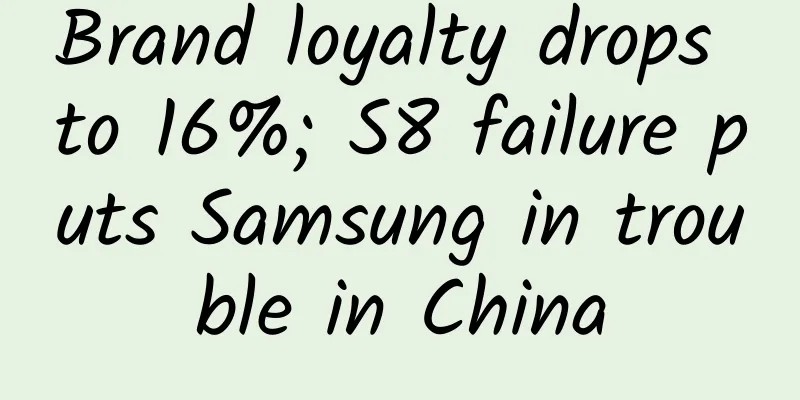Brand loyalty drops to 16%; S8 failure puts Samsung in trouble in China

|
The Galaxy S8 was seen by DJ Koh, the head of Samsung's mobile phone business, as a "turning point" in the Chinese market, but judging from actual market sales, DJ Koh is disappointed again. According to detailed sales data obtained from Samsung channel personnel, as of May 31, Samsung Galaxy S8 series sales in the Chinese market reached 189,000 units (first sale in the Chinese market began on May 25); the overall sales data in June was about 290,000 units (including JD.com's 6.18 promotion); and in the first half of July, its average daily shipments were about 8,000 units. It can be seen that the sales of Samsung Galaxy S8 series in the Chinese market have declined significantly after only two months of sales, and in the global market, Galaxy S8 is far from meeting Samsung's expectations. According to the Korea Pioneer report, Samsung's Galaxy S8 series sold 9.8 million units worldwide in 60 days, a 20% drop from its previous generation Galaxy S7 (12 million units) in the same period. That is to say, in China, the world's largest smartphone market, Samsung Galaxy S8 has sold about 600,000 units so far, accounting for about 6.1% of global sales. The "turning point" expected by Gao Dongzhen did not appear. Under market pressure, Gao Dongzhen recently took the initiative to reveal to the media: "Samsung Galaxy Note8 will appear as early as the end of August." However, with the Galaxy S8 release date delayed and less than two months on the market in China, Koh Dong-jin's move has undoubtedly aggravated the wait-and-see attitude of Chinese Samsung users, and made the sales of Galaxy S8 even worse. At the same time, Samsung's Galaxy C series, which was customized for the Chinese market and intended to focus on sales, also saw a significant decline in June this year due to the erosion of domestic mobile phones. The average daily sales of the Galaxy C7 series fell to about 5,000 units, and the Galaxy C5 series fell to about 3,000 units. A senior Samsung channel staff member complained: "Samsung's mobile phones have been collapsing since 2014. In the past three years, the brand, channels, employees and other aspects have been in a state of dire straits. The Galaxy S8 alone cannot save Samsung's market in China." Samsung's brand confusion: declining premium vs. ultra-high pricing High premiums are a test of a company's comprehensive capabilities in terms of brand, product, and channel. The mismatch between pricing and market reality was one of the important reasons why Nokia and HTC failed during the market transition period, and it is also the problem that Samsung mobile phones are facing in China today. Since 2011, Chinese high-end smartphone users have gone through more than three cycles of replacing their smartphones, and consumer rationality is returning. The most notable examples are Vertu's retreat from the Chinese market and Samsung's ultra-high-priced 10,000-yuan W series being abandoned by China's military and political personnel and high-end business users. At the same time, Chinese mobile phone brands such as Huawei in the market above 4,000 yuan, and OPPO and vivo in the market above 3,000 yuan began to "harvest" Samsung's original mid-to-high-end users on a large scale. The actual offline selling price of Huawei Mate 9 Porsche Edition exceeded 10,000 yuan, successfully eroding Samsung's W series.
According to Canalys' mobile phone data on the Chinese market released in April 2016 and April 2017, Samsung's market share in the price segment above 4,000 yuan dropped sharply from 18.2% to 2.3%; its share in the price segments of 3,000-3,999 yuan and 2,500-2,999 yuan dropped to 1.8% and 1.7% respectively, and it was basically out of the market in the price segment below 2,500 yuan. User loyalty is also an important consideration for corporate brands. According to the "2016 Smartphone Micro Report" released by Canalys and Weibo, in the past three years, Samsung's user brand loyalty in the Chinese market has dropped from 18% to 12%. In comparison, Apple is 71%, OPPO is 31%, vivo is 29%, and Huawei is 26%. Samsung's user brand loyalty even lags behind LeTV (15%).
The "2016 Mobile Phone Report" released by Toutiao Arithmetic Center also confirms this trend: the brand loyalty of Samsung users who change phones is only 16.64%, 25% of which switch to iPhone and 20% to Huawei.
The Samsung Note 7 "explosion incident" in 2016 caused severe damage to Samsung's brand reputation in the Chinese market because Samsung's recall in mainland China was 40 days later than in other countries. Money can be earned again if lost, and opportunities can be lost if lost, but the loss of brand image is irreversible. It takes years to build a brand, but it only takes a day to destroy a brand. According to survey data released by Morgan Stanley afterwards, the proportion of users in the Chinese market who are willing to buy Samsung mobile phones has dropped significantly. According to the latest data released by the GfK Group, Samsung's mobile phone market share in China fell to 2.3% in April 2017, which is a far cry from its 19.7% market share in China in 2013.
Faced with the most fiercely competitive Chinese smartphone market in the world, faced with Chinese users who are no longer forgetful, and faced with the suspension of South Korean celebrity endorsement strategy in China, Samsung is actually facing a huge brand reshaping challenge. At this time, it needs to adopt a more people-friendly pricing strategy and strengthen interaction and understanding with Chinese users. However, Samsung's approach was to reverse the trend and raise the price of Galaxy S8 to an ultra-high price range of more than 5,700 yuan, even significantly exceeding the brand premium ability of Apple iPhone, which has a user loyalty of up to 70% and is significantly higher than its own. During the downward market trend, Samsung is reshaping the mistakes made by Nokia and HTC in the mainland market. Behind the Galaxy S8's sales figures that fell short of expectations is the real choice made by Chinese users with real money. Samsung's channel confusion: It's hard to maintain the trust of hurt partners Before the rise of OPPO and vivo smartphone businesses, Samsung controlled the largest offline sales channel in the Chinese mobile phone market. Taking advantage of Nokia's collapse, Samsung recruited a large number of Nokia's Chinese channel personnel and fully introduced Nokia's FD model, whose main features are: eliminating national agents and operators, introducing FD platform providers in provinces across the country, and strengthening control over third- and fourth-tier channels. Nokia's rise and fall have proven that the FD model is a double-edged sword. Its success requires three basic factors: the mobile phone must have a high brand premium to bring higher profits to channel dealers; the product shipment scale must be large to meet the channel dealers' sufficient supply and cash flow; at the same time, there must be strong control over the channel to prevent channel cross-selling and private price cuts from disrupting the overall market. In a market where the dual Galaxy flagship strategy was going smoothly, Samsung and its channel partners under the FD model were guaranteed high profits, but the issuance of 4G licenses in China became the turning point for Samsung's channel collapse. Due to a serious misjudgment of the explosion of China's TD-LTE 4G market, especially China Mobile's announcement of the complete cancellation of 3G subsidies that year, Samsung's 3G mobile phones were seriously overstocked in the Chinese market. The industry estimates that the number of Samsung 3G mobile phones in stock in the Chinese market channels exceeds 1 million units. In the second quarter 2014 financial report, Samsung executives publicly admitted that "the company's inventory management, China business, and tablet sales all had problems," and blamed the increasing competitive pressure from Chinese smartphone manufacturers. Samsung Electronics China launched a "price guarantee" strategy with a total value of 2.5 billion yuan in an attempt to stabilize its shaky sales channels in China. However, the "dumping" strategy and unrealistic KPIs forced by Samsung headquarters became the "last straw" that triggered the collapse of the channel. The sales director of Samsung Mobile in China began to turn a blind eye to regional cross-selling and dealers' random pricing, and dealers at all levels of the channel did not dare to purchase in bulk in the face of the chaotic situation. They were even willing to lose 100 yuan to clear inventory and ship out goods quickly, with the aim of taking advantage of Samsung's 200 yuan "price guarantee." Ultimately, the channel built on the FD model went down the same path of collapse as Nokia, which not only left a painful lesson that is still indelible to this day for channel partners at all levels, but also had a negative impact on the subsequent offline sales of Samsung flagship phones. For example, 48 days after the Galaxy Note7 "explosion incident", Samsung announced the recall of Galaxy Note7 phones sold in the Chinese market, totaling approximately 190,000 units. This sales figure created the worst record for Samsung's flagship new product's first sale in China that month, and once again deepened Chinese channel dealers' doubts and dissatisfaction with Samsung. Even during the short premium period when the Galaxy S8 was first launched in China, no channel dealer dared to "speculate" in large quantities. Compared with Samsung, the rising OPPO and vivo adopted a more "honest" cooperation method with channel dealers. For example, after OPPO was established, many of BBK's second-tier agents, suppliers, and employees became OPPO's provincial agents, and even many agents held shares in OPPO. The identification with corporate culture, trust in OPPO, and common interests have enabled OPPO to quickly establish a huge channel system covering county and township markets across the country, with more than 5,000 directly-operated stores and over 200,000 sales outlets, while also curbing the phenomenon of channel diversion and chaotic pricing in the market. Faced with the channel dilemma in China, Samsung Electronics China announced in July this year that it would abolish its seven major branches in China and turn them into 26 offices. Leaders at the level of general manager, deputy director, and vice president would become the heads of each office. Samsung told the media that it would strengthen the retail capabilities of its channels, streamline levels, respond to changing competition, and quickly adjust sales plans to increase sales. This adjustment shows that Samsung is seriously dissatisfied with the channel capacity in the Chinese mobile phone market. But can the transformation of seven branches into 26 offices help Samsung carve out channel space among many Chinese competitors such as OPPO, vivo, Huawei, and Gionee? Rebuilding channel trust is obviously more urgent and realistic for Samsung. Samsung China employees' confusion: lack of localization The most valuable asset of a company is its people. For multinational companies, the cohesion of local employees is the basis for success in the local market. However, many negative factors, such as employee disappointment, constant salary cuts and layoffs, and lack of room for advancement, are accelerating the rapid loss of Samsung Mobile's Chinese employees. The Galaxy Note 7 "explosion scandal" also dealt a heavy blow to Samsung's internal employees in China. Under the crisis, Samsung Electronics China employees were asked to "keep silent" and even had no right to take the initiative to conduct crisis public relations. Everything had to be arranged by Samsung's South Korean headquarters. The recall decision, which came 40 days later than other countries, triggered unanimous "bombardment" from Chinese media and users on social platforms, and also aroused strong dissatisfaction among Samsung Electronics' Chinese employees. "From that time on, Samsung Electronics' sales and marketing staff in China began to leave in large numbers," said a former Samsung employee who switched to a local Chinese Internet company. At the same time, the rapidly declining performance in China has also forced Samsung Electronics China to continuously cut operating and labor costs. According to Samsung Electronics' 2016 public financial data, the total number of Samsung employees in 2016 fell for the first time in seven years, from 326,000 in the previous year to 309,000, a decrease of 5.2%. The hardest hit area was China. In 2016, the number of Samsung employees in China was 37,070, a decrease of 17.5% from 44,948 in the previous year. In April this year, Samsung Electronics China announced that the company had adjusted its employee salary system again after 2016: the salary for the 13th month of the previous 13-salary system was distributed evenly over 12 months, and at the same time, 60%-80% of the monthly salary was paid out based on the functions of different departments, and the remaining part was paid at the end of the year based on KPI assessment. However, Samsung’s internal employees said that with the continuous decline of mobile phone business in China, the high KPIs set by Samsung for employees in China are "almost impossible to achieve." Taking 2016 as an example, the average assessment rate for sales positions was less than 80%. "The purpose of doing this is obvious, which is to reduce salaries in disguise and force employees to resign." In fact, the localization of Japanese and Korean companies in China has always been questioned. Take Samsung as an example. It has entered the Chinese market for 25 years, but the management of its Chinese company still trusts Koreans, followed by Chinese Korean employees. In recent years, in order to strengthen localization, Samsung has required that managers at the ministerial level and above who are sent from South Korea to China must understand Chinese. At the same time, it has made an exception and promoted several senior executives of its mobile phone business in China, but this is limited to aspects such as cooperation with the government and operators and does not involve Samsung's core business. In a recent interview with Chinese media, Koh Dong-jin said that Samsung's focus is not to follow the footsteps of its competitors, but to follow its own long-term planning roadmap, including hardware, software and services. Samsung's Chief Marketing Officer Lee Young-hee made it clear: "Samsung provides not only hardware devices, but also excellent services. This is the difference from Chinese brands." An employee of Samsung Electronics China joked about this: It is really ironic that a Korean mobile phone company that cannot even decide on pre-installed apps in China can actually talk about "excellent service" in the Chinese market. Interestingly, Bixby, the voice assistant that Lee Young-hee regarded as one of the Samsung Galaxy ecosystem services, was not launched in English until three months after the Galaxy S8, the first mobile phone device it was intended to be equipped with, was released. The Chinese version is still a long way off, while related intelligent voice solutions have long been popular among its Chinese competitors. The above-mentioned Samsung Electronics China employee revealed that Chinese software engineers do not have product control, but due to language, mobile Internet services, data and other issues, communication and collaboration with the Korean headquarters are not smooth. "It is estimated that this problem will not be solved when the Galaxy Note8 is launched in the Chinese market." Based on the above information, we believe that since the beginning of 2016, Koh Dong-jin, as the "boss" of Samsung's mobile phone business, has always told the outside world that Samsung mobile phones are "about to revive" in the Chinese market. However, the reality of long-standing problems in terms of brand, channels, employees, etc. has made Koh Dong-jin break his promises time and time again. According to statistics from the first six months of the Chinese market released by research firm Canalys, Samsung's shipments in China's offline market plummeted again by 65.8% in 2017 to only 4.476 million units, and its market share has dropped to eighth place. Its average monthly shipments are only about 746,000 units, equivalent to nearly 1/9 of OPPO (offline market), nearly 1/8 of Huawei, and nearly 1/5 of Apple. From a hardware perspective, the Galaxy S8 is an excellent Android flagship phone, but Samsung's brand premium today is completely unable to support its ultra-high price of more than 5,700 yuan. The damaged channels will find it difficult to restore their trust in Samsung in a short period of time, and employees in the Chinese region are unable to form cohesion and combat effectiveness. The more worthy question is, can the problems that Galaxy S8 cannot solve be avoided by the upcoming Galaxy Note8? As a winner of Toutiao's Qingyun Plan and Baijiahao's Bai+ Plan, the 2019 Baidu Digital Author of the Year, the Baijiahao's Most Popular Author in the Technology Field, the 2019 Sogou Technology and Culture Author, and the 2021 Baijiahao Quarterly Influential Creator, he has won many awards, including the 2013 Sohu Best Industry Media Person, the 2015 China New Media Entrepreneurship Competition Beijing Third Place, the 2015 Guangmang Experience Award, the 2015 China New Media Entrepreneurship Competition Finals Third Place, and the 2018 Baidu Dynamic Annual Powerful Celebrity. |
Recommend
Launch a rocket to welcome the Spring Festival! If you want to understand the Land Exploration No. 1 Group A, you need to know these keywords
Your browser does not support the video tag Video...
Animals can also become "addicts"! How do drugs make the brain addicted?
Maybe you have seen the dog in the picture below,...
Tsinghua University teacher Pan Pan's learning motivation
Tsinghua University teacher Pan Pan's introdu...
Lu Mingming · Xiaohongshu Hot Fan Training Class 5.0, help you easily play Xiaohongshu platform worth 1380 yuan
Lu Mingming · Xiaohongshu Fan Training Class 5.0,...
Just because the name is Navigation, does that mean it can only be used for navigation?
hey, Beidou! China's Beidou, the world's ...
When a person dies, is the body completely dead? Some genes are still trying to revive the human body
Death represents the end, because everything we h...
Are foods highly toxic after they sprout? Some foods can cause poisoning, while others have doubled nutritional value...
This article was reviewed by Liu Shaowei, food sa...
There are certain rules to follow when taking medicine. Are you still taking medicine the wrong way?
Everyone knows that taking the wrong medicine may...
Samsung is not alone: Apple phone explosion may trigger chain reaction
Throughout September, the explosion of Samsung No...
How to do well in Baidu Q&A? How to do marketing promotion on Baidu Q&A?
There are many ways of online promotion, such as:...
Baidu invested in Uber, Li Yanhong's intention is not "taking a taxi"
The day before yesterday afternoon, the cross-bor...
Understanding of the concept of seo, how to understand seo?
Understanding of the concept of seo, how to under...
4 replicable refined operation methods!
The fission gameplay template is important, but w...
If you can't find the code, it's all fake. What should you pay attention to when filling out college entrance examination applications?
According to the Ministry of Education website, o...
"Shi Sanxi · The Essence of Eight Mansions" Rediscover the Magical Uses of Eight Mansions Feng Shui
"Shi Sanxi·The Essence of Eight Mansions&quo...









